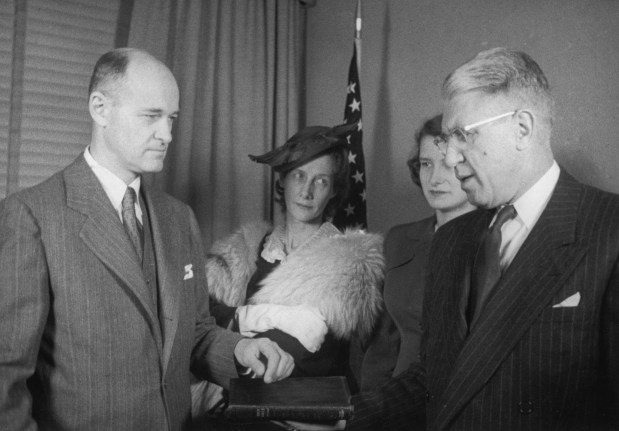The document that largely defined American foreign policy through the Cold War years was written anonymously by a prickly and melancholic Midwesterner who spent much of the rest of his life disavowing the repercussions of his work.
George F. Kennan, a State Department expert on Soviet Russia, published an article in the July 1947 issue of Foreign Affairs but signed it “X” because of his government role. The article famously called for the “containment” of Soviet expansion, urging the United States and the West to “confront the Russians with unalterable counter-force at every point where they show signs of encroaching upon the interests of a peaceful and stable world.”
The containment principle, as subsequently interpreted, produced strategies and actions ranging from the Marshall Plan to the covert activities of the CIA to the disastrous Vietnam War. At the same time, containment put unrelenting pressure on the Soviet Union and arguably led eventually to the internal collapse of the clumsy and ossified Soviet government — an outcome Kennan predicted.
Almost immediately after publication of the article, Kennan realized that his prescription lacked specificity. He’d meant to suggest that the spearhead of containment should be political and economic, not military, and that the concern with Soviet expansion should focus on Europe, not the entire world. When his successor at the State Department, Paul Nitze, globalized containment in National Security Council Paper No. 68 and provided a rationale for the Truman Doctrine — which promised an American response to any communist threat — Kennan loudly protested in vain. For decades he inveighed against the misuse of containment, notoriously during the Vietnam War.
With the Russian invasion of Ukraine, talk of containment has resurfaced. One school of thought argues that this latest manifestation of Russian expansionist desires must be fiercely opposed. Another, drawing on comments made by Kennan himself, suggests that the expansion of NATO led to the invasion by provoking Russia’s historic paranoia about its borders.
But Kennan, who died in 2005, recognized that containment alone isn’t enough. At the conclusion of the X article, Kennan turns his attention from the character of the Soviet Union to the character of the United States and makes an entirely different point — one that’s often overlooked and that remains profoundly relevant. To be an architect of peace and stability around the globe, Kennan wrote, America must “create among the peoples of the world generally the impression of a country which knows what it wants, which is coping successfully with the problems of its internal life and with the responsibilities of a World Power, and which has a spiritual vitality capable of holding its own among the major ideological currents of the time.”
With those words, Kennan could be speaking to all Americans today. We would do well to listen.
As historian John Lewis Gaddis makes clear in his acclaimed Kennan biography, his subject was a curious mixture. Kennan was a lonely child whose mother died shortly after his birth, a difficult colleague and frustrated diplomat, an elitist more at home in another century and a pessimist at heart. He abhorred the messianism ascribed to President Woodrow Wilson that dominated American foreign policy for several decades after World War I. As much as Kennan despised the Stalinist regime, he loved the Russian people, and he astutely analyzed that the communist government held “within it the seeds of its own decay.”
In the X article, he warned against letting similar seeds take root in American soil. He’d witnessed how “exhibitions of indecision, disunity and internal disintegration” in the United States produced a “new jauntiness” in “the Moscow tread.”
Today, America’s enemies around the globe are no doubt treading with the same jauntiness as the country fractures into factions and is immobilized by polarization.
In the X article, Kennan’s simple advice to his native land was to “measure up to its own best traditions.” The specter of nuclear annihilation loomed only dimly in his thoughts, but Kennan recognized that competition with Soviet totalitarianism held immeasurable risks. Still, he looked at the Soviet menace as a “test of the overall worth of the United States as a nation among nations.” Providence, he wrote, had provided “the American people with this implacable challenge, has made their entire security as a nation dependent on their pulling themselves together and accepting the responsibilities of moral and political leadership that history plainly intended them to bear.”
Seventy-seven years after Kennan wrote those words, they have never been more on the mark.
John E. Rielly is emeritus president of the Chicago Council on Global Affairs and author of the forthcoming memoir “My Foreign Affairs.” Richard Babcock, former editor of Chicago magazine, is a novelist.
Submit a letter, of no more than 400 words, to the editor here or email letters@chicagotribune.com.



